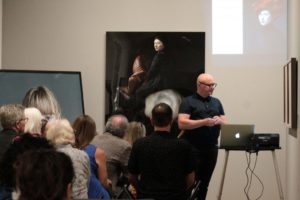Photo interpretation tool helps substance abuse prevention program examine the role of racism on health
- MOPA helped a photovoice study on racism as a social determinant of health funded by Ventura County Behavioral Health Department to further prevention innovation
- Youth in the City of Oxnard used interpretation of their pictures to lead a year-long dialogue with their community, including local policy makers
The Museum of Photographic Arts (MOPA) helped a substance abuse prevention program examine the role of racism on health. By inspiring dialogue, photography can prompt systemic change.
Through a training session on photo interpretation with R. Bong Vergara, research consultant and principal investigator at the Ventura County of Behavioral Health (VCBH) department, MOPA Director of Innovation Joaquin Ortiz supported VCBH as it planned the youth-driven community study, called PhotoVoice Oxnard.
BRITE Youth Services, which promotes social change regarding underage drinking and impaired driving, implemented PhotoVoice Oxnard by engaging youth in the City of Oxnard in Ventura County.
Now in its second round, PhotoVoice puts cameras into the hands of youth to 1) document, 2) reflect upon and 3) communicate issues of concern— all with the purpose of promoting community-driven race-conscious system change, program innovation, and policy reform in behavioral health.
The end goals include to:
- Enable people to record and reflect their community’s strengths and concerns about how racism affects their mental health and substance use risk,
- Promote critical dialogue about racism’s impact on mental health and substance abuse through small group discussions of photographs, and
- Collaborate with decision makers in addressing systemic racism.
Its first iteration (round one) finished in June 2020. The PhotoVoice Oxnard website includes the images and audio stories of Latino youth participants, in addition to group responses to queries like “What are we looking at?” and “What is really going on here?”
Now in its recruitment phase, round two started in July 2020 to recruit Black and Samoan youth who live in Oxnard. Youth interested in participating can contact photovoice@briteyouth.org.
Visit PhotoVoice Oxnard for the full gallery and audio stories.
How can visual literacy help address the role of racism on health?
“Interpreting a photo is just like reading a page from a book,” Ortiz said.
Programming at MOPA is based on exploring visual literacy. A visually literate individual maintains an understanding of the social, cultural, political and economic framework of the image and its message.
Through visual literacy strategies, PhotoVoice Oxnard gathered information that will give direction to VCBH’s race-conscious substance abuse prevention program. The data will also strengthen its health promotion plan for racial minorities.
VCBH gathered local data through PhotoVoice Oxnard by asking questions that were consciousness-raising and nudged critical thinking. The questions linked the personal with the political. They asked the individual to arrive at possible program innovations and policy reforms.
Jacqueline Cortez participated in round one of PhotoVoice Oxnard with an image sequence titled “Fire.” The pictures show smoke from the Maria Fire in 2019, which burned thousands of acres in Ventura County. Jacqueline shared the images and story with a group, asking questions like “How does it affect us?” and “What can we do about it?”
To the latter, the group addresses language inequities and online access regarding news or information distributed about the fire. The group response said:
The community needs better access to information. One student received an email from the county in English, and had to translate it for her mom. What about families who don’t have email accounts, internet access, or someone to translate for them? How is information being distributed? In English and Spanish? We need updates on air conditions, the location of fires, etc. Schools send out information via email or text but not all parents have access to this technology – there is a huge gap in access to information. Schools can implement fire resources now that fires are normal.
A sequence titled “Medicine Cabinet & Opioid Brochures” by youth participants Lucia Sanchez and Yosduan Ramos also prompted a group response about language inequities. “We need to inform the public about the dangers of access to prescription drugs … We could have trainings to show people how to take care of their medications and how to prevent access to teens. There would need to be interpreters in Spanish and Mixteco … “
“To commit to a race-conscious program that advances prevention practices, we first need to build critical dialogue on racism among people and policy makers, and that’s what PhotoVoice Oxnard does,” said Vanessa Alva, program manager at BRITE Youth Services.
“We are on a fact-finding effort on how racism impacts behavioral health in Oxnard to enable the community to shape a race-conscious behavioral health program and address local systemic racism,” Vergara said.
Press Inquiries
Press Coordinator




